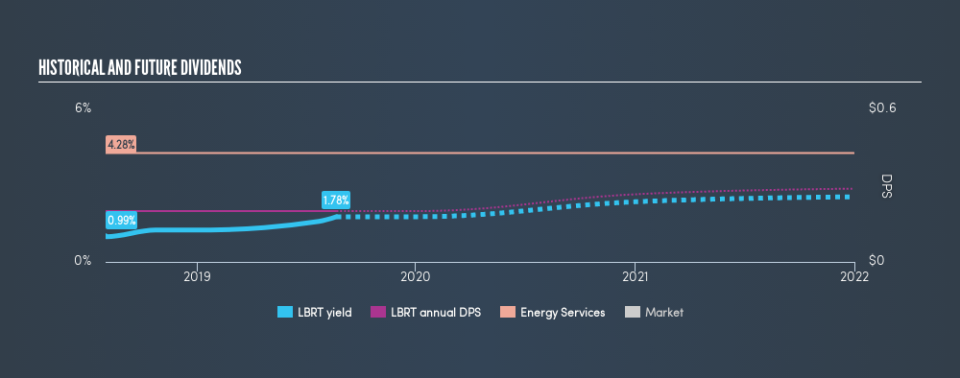Here's What You Should Know About Liberty Oilfield Services Inc.'s (NYSE:LBRT) 1.8% Dividend Yield

Is Liberty Oilfield Services Inc. (NYSE:LBRT) a good dividend stock? How can we tell? Dividend paying companies with growing earnings can be highly rewarding in the long term. Unfortunately, it's common for investors to be enticed in by the seemingly attractive yield, and lose money when the company has to cut its dividend payments.
Liberty Oilfield Services has only been paying a dividend for a year or so, so investors might be curious about its 1.8% yield. The company also bought back stock equivalent to around 7.8% of market capitalisation this year. There are a few simple ways to reduce the risks of buying Liberty Oilfield Services for its dividend, and we'll go through these below.
Explore this interactive chart for our latest analysis on Liberty Oilfield Services!
Payout ratios
Companies (usually) pay dividends out of their earnings. If a company is paying more than it earns, the dividend might have to be cut. So we need to form a view on if a company's dividend is sustainable, relative to its net profit after tax. Looking at the data, we can see that 15% of Liberty Oilfield Services's profits were paid out as dividends in the last 12 months. We'd say its dividends are thoroughly covered by earnings.
Another important check we do is to see if the free cash flow generated is sufficient to pay the dividend. Liberty Oilfield Services's cash payout ratio last year was 20%, which is quite low and suggests that the dividend was thoroughly covered by cash flow. It's encouraging to see that the dividend is covered by both profit and cash flow. This generally suggests the dividend is sustainable, as long as earnings don't drop precipitously.
Consider getting our latest analysis on Liberty Oilfield Services's financial position here.
Dividend Volatility
One of the major risks of relying on dividend income, is the potential for a company to struggle financially and cut its dividend. Not only is your income cut, but the value of your investment declines as well - nasty. With a payment history of less than 2 years, we think it's a bit too soon to think about living on the income from its dividend. Its most recent annual dividend was US$0.20 per share.
It's good to see at least some dividend growth. Yet with a relatively short dividend paying history, we wouldn't want to depend on this dividend too heavily.
Dividend Growth Potential
The other half of the dividend investing equation is evaluating whether earnings per share (EPS) are growing. Over the long term, dividends need to grow at or above the rate of inflation, in order to maintain the recipient's purchasing power. Liberty Oilfield Services's earnings per share have fallen -51% over the past year. This is a pretty serious concern, and it would be worth investigating whether something fundamental in the business has changed - or broken. We do note though, one year is too short a time to be drawing strong conclusions about a company's future prospects.
Conclusion
When we look at a dividend stock, we need to form a judgement on whether the dividend will grow, if the company is able to maintain it in a wide range of economic circumstances, and if the dividend payout is sustainable. Firstly, we like that Liberty Oilfield Services has low and conservative payout ratios. Unfortunately, there hasn't been any earnings growth, and the company's dividend history has been too short for us to evaluate the consistency of the dividend. While we're not hugely bearish on it, overall we think there are potentially better dividend stocks than Liberty Oilfield Services out there.
Without at least some growth in earnings per share over time, the dividend will eventually come under pressure either from costs or inflation. See if the 13 analysts are forecasting a turnaround in our free collection of analyst estimates here.
If you are a dividend investor, you might also want to look at our curated list of dividend stocks yielding above 3%.
We aim to bring you long-term focused research analysis driven by fundamental data. Note that our analysis may not factor in the latest price-sensitive company announcements or qualitative material.
If you spot an error that warrants correction, please contact the editor at editorial-team@simplywallst.com. This article by Simply Wall St is general in nature. It does not constitute a recommendation to buy or sell any stock, and does not take account of your objectives, or your financial situation. Simply Wall St has no position in the stocks mentioned. Thank you for reading.

